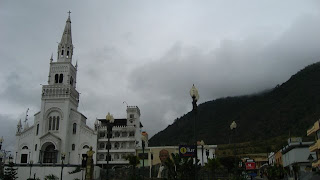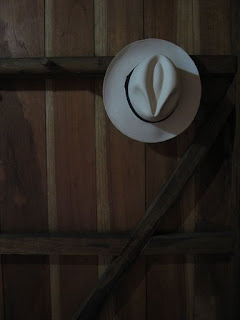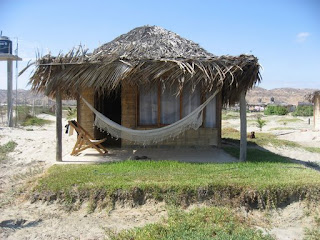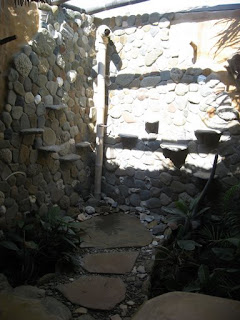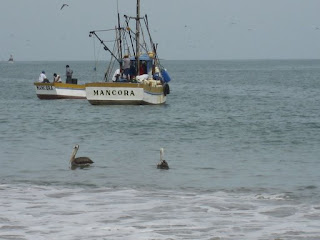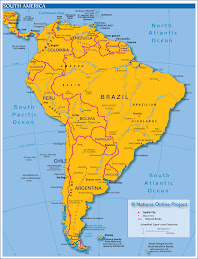 Canoa is a tiny little beach villiage reasonably close to the town of San Vicente, which lies across a large inlet in the sea from Bahia de Caraquez, a city (with only 2 ATMs for christ´s sake!). The town itself (Canoa) consists of one main road along the beach (made of sand which sort of just morphs into the beach sand), and another main road which extends about 3 blocks up and away from the beach, where you get to the road out of town, which sits next to some medium size cliffs. Are you picturing it right now? Good.
Canoa is a tiny little beach villiage reasonably close to the town of San Vicente, which lies across a large inlet in the sea from Bahia de Caraquez, a city (with only 2 ATMs for christ´s sake!). The town itself (Canoa) consists of one main road along the beach (made of sand which sort of just morphs into the beach sand), and another main road which extends about 3 blocks up and away from the beach, where you get to the road out of town, which sits next to some medium size cliffs. Are you picturing it right now? Good. The entire town appears to be made of bamboo,  with light wooden frames. They take thick pieces of bamboo and flatten them out to make panels with which they build everything. Considering there was a massive earthquake in Bahia in 2002, I don´t think they´re being too smart, but hey, what do I know about antiseismic construction? While not very sensible, the building habit does give the town a really laid back look, and makes the buildings blend in with the palm tree lined beach, and makes you want to order horribly sweet and colourful cocktails and fake a jamaican accent. Alright mon, I be ramblin on bout one or two tings.
with light wooden frames. They take thick pieces of bamboo and flatten them out to make panels with which they build everything. Considering there was a massive earthquake in Bahia in 2002, I don´t think they´re being too smart, but hey, what do I know about antiseismic construction? While not very sensible, the building habit does give the town a really laid back look, and makes the buildings blend in with the palm tree lined beach, and makes you want to order horribly sweet and colourful cocktails and fake a jamaican accent. Alright mon, I be ramblin on bout one or two tings.
 with light wooden frames. They take thick pieces of bamboo and flatten them out to make panels with which they build everything. Considering there was a massive earthquake in Bahia in 2002, I don´t think they´re being too smart, but hey, what do I know about antiseismic construction? While not very sensible, the building habit does give the town a really laid back look, and makes the buildings blend in with the palm tree lined beach, and makes you want to order horribly sweet and colourful cocktails and fake a jamaican accent. Alright mon, I be ramblin on bout one or two tings.
with light wooden frames. They take thick pieces of bamboo and flatten them out to make panels with which they build everything. Considering there was a massive earthquake in Bahia in 2002, I don´t think they´re being too smart, but hey, what do I know about antiseismic construction? While not very sensible, the building habit does give the town a really laid back look, and makes the buildings blend in with the palm tree lined beach, and makes you want to order horribly sweet and colourful cocktails and fake a jamaican accent. Alright mon, I be ramblin on bout one or two tings. While the town at first appears to be super laid back, all this changes when the sun goes down, when the two main disco bars (which are opposite each other) open their doors, put their speakers outside and play the worst music you have ever heard. Since they are clearly competing with each other, both bars keep turning the music up until it distorts horribly, and The Worst Music in the World ceases to be music at all. This continent has some great music, although I have no idea where the hell it is, because for some reason everybody just listens to something called Reggaeton. If it sounds bad, its because it is. It generally involves a hip hop beat that sounds as if a psychopathic child made it, one morning right after he put his cat in the microwave. On top of this they dub some really bad rapping (more like someone just shouting at you), and then for good measure they add all the sound effects they can - sirens, hooters, breaking glass, truck horns, whistles... Its really really awful. So after sitting at one of these horrible bars, Nadia and I returned back to our hostel (on the same street as both satan bars), feeling that we were not going to sleep well, and that Canoa´s nightlife was not going to be nearly as good as its daylife.
While the town at first appears to be super laid back, all this changes when the sun goes down, when the two main disco bars (which are opposite each other) open their doors, put their speakers outside and play the worst music you have ever heard. Since they are clearly competing with each other, both bars keep turning the music up until it distorts horribly, and The Worst Music in the World ceases to be music at all. This continent has some great music, although I have no idea where the hell it is, because for some reason everybody just listens to something called Reggaeton. If it sounds bad, its because it is. It generally involves a hip hop beat that sounds as if a psychopathic child made it, one morning right after he put his cat in the microwave. On top of this they dub some really bad rapping (more like someone just shouting at you), and then for good measure they add all the sound effects they can - sirens, hooters, breaking glass, truck horns, whistles... Its really really awful. So after sitting at one of these horrible bars, Nadia and I returned back to our hostel (on the same street as both satan bars), feeling that we were not going to sleep well, and that Canoa´s nightlife was not going to be nearly as good as its daylife.The daylife was good. We spent our days lying around on the beach, swimming in the warm water, exploring the bay, eating more incredible seafood for next to nothing, and generally just chilling out and being beach bums. Our evenings got better after our discovery of the Surf Shak, a cool little bar run by a dutch guy called Frans who has been living in Canoa for 3 years, running the bar and giving jobs to the travellers who pass through. The Surf Shak was a good place to kick back over a beer and meet some other travellers. The evening we stumbled upon it happened to be one of the employees, Konrad´s, birthday, and this resulted in most of the night being turned into happy hours (Frans proudly proclaimed that if he´d wanted to make money he would have stayed in Europe), and us being invited to Konrad´s birthday bonfire on the beach, a party organised for him by the locals. Konrad is from Switzerland and has been in Canoa for a few months. We arrived to find a proper bonfire (a good 5 meters of wood in flames), a braai with fresh fish sizzling away, and some rather drunk locals, who keep giving us whole fish straight off the braai. They were the most delicious fish ever.
discovery of the Surf Shak, a cool little bar run by a dutch guy called Frans who has been living in Canoa for 3 years, running the bar and giving jobs to the travellers who pass through. The Surf Shak was a good place to kick back over a beer and meet some other travellers. The evening we stumbled upon it happened to be one of the employees, Konrad´s, birthday, and this resulted in most of the night being turned into happy hours (Frans proudly proclaimed that if he´d wanted to make money he would have stayed in Europe), and us being invited to Konrad´s birthday bonfire on the beach, a party organised for him by the locals. Konrad is from Switzerland and has been in Canoa for a few months. We arrived to find a proper bonfire (a good 5 meters of wood in flames), a braai with fresh fish sizzling away, and some rather drunk locals, who keep giving us whole fish straight off the braai. They were the most delicious fish ever.
 discovery of the Surf Shak, a cool little bar run by a dutch guy called Frans who has been living in Canoa for 3 years, running the bar and giving jobs to the travellers who pass through. The Surf Shak was a good place to kick back over a beer and meet some other travellers. The evening we stumbled upon it happened to be one of the employees, Konrad´s, birthday, and this resulted in most of the night being turned into happy hours (Frans proudly proclaimed that if he´d wanted to make money he would have stayed in Europe), and us being invited to Konrad´s birthday bonfire on the beach, a party organised for him by the locals. Konrad is from Switzerland and has been in Canoa for a few months. We arrived to find a proper bonfire (a good 5 meters of wood in flames), a braai with fresh fish sizzling away, and some rather drunk locals, who keep giving us whole fish straight off the braai. They were the most delicious fish ever.
discovery of the Surf Shak, a cool little bar run by a dutch guy called Frans who has been living in Canoa for 3 years, running the bar and giving jobs to the travellers who pass through. The Surf Shak was a good place to kick back over a beer and meet some other travellers. The evening we stumbled upon it happened to be one of the employees, Konrad´s, birthday, and this resulted in most of the night being turned into happy hours (Frans proudly proclaimed that if he´d wanted to make money he would have stayed in Europe), and us being invited to Konrad´s birthday bonfire on the beach, a party organised for him by the locals. Konrad is from Switzerland and has been in Canoa for a few months. We arrived to find a proper bonfire (a good 5 meters of wood in flames), a braai with fresh fish sizzling away, and some rather drunk locals, who keep giving us whole fish straight off the braai. They were the most delicious fish ever.Apart from Konrad, we met Greg, a large chap from Kentucky who´d also been living in Ecuador for three years. Greg runs a hotel on the beach and also sells beachfront real estate (which, by the way, if anyone is interested in a good investment, sells for $100 a square meter, and is going up and up and up). Aside from that, he has a stake in Surf Shak, and so occaisionally mans the bar (and occaisionally dances on it). He also takes travellers on tandem paragliding flights. We had heard about the paragliding and so inquired with Frans, who told us Greg would be arriving soon. He arrived in his truck, jumped out and said, in a strong Kentucky accent, `Who´s goin flyin?´, and when we said we were interested, he replied `Let me just get these 3 shots of tequila in me and we´ll get goin`. He was joking. As it turns out the light didn´t last long enough for us to go that day, but we patiently waited, and were rewarded with a perfect sunset and perfect winds, and had one of the best experiences of the trip so far. Basically, Greg took us up to his launch site on the cliffs behind Canoa, attached one of us to his harness, and we ran off the cliff. Needless to say, it was an amazing experience - for 30 minutes we were birds, flying around wherever we wanted. The idea is to use the constant winds that hit the cliffs and rise up to get a bit of altitude, and then follow the birds into the thermals that randomly form, thus getting more and more altitude and allowing for a longer flight. After about half an hour though, the flight was over and we landed gently on the beach. We both decided then and there that we had to learn how to do that.
`Who´s goin flyin?´, and when we said we were interested, he replied `Let me just get these 3 shots of tequila in me and we´ll get goin`. He was joking. As it turns out the light didn´t last long enough for us to go that day, but we patiently waited, and were rewarded with a perfect sunset and perfect winds, and had one of the best experiences of the trip so far. Basically, Greg took us up to his launch site on the cliffs behind Canoa, attached one of us to his harness, and we ran off the cliff. Needless to say, it was an amazing experience - for 30 minutes we were birds, flying around wherever we wanted. The idea is to use the constant winds that hit the cliffs and rise up to get a bit of altitude, and then follow the birds into the thermals that randomly form, thus getting more and more altitude and allowing for a longer flight. After about half an hour though, the flight was over and we landed gently on the beach. We both decided then and there that we had to learn how to do that.
 `Who´s goin flyin?´, and when we said we were interested, he replied `Let me just get these 3 shots of tequila in me and we´ll get goin`. He was joking. As it turns out the light didn´t last long enough for us to go that day, but we patiently waited, and were rewarded with a perfect sunset and perfect winds, and had one of the best experiences of the trip so far. Basically, Greg took us up to his launch site on the cliffs behind Canoa, attached one of us to his harness, and we ran off the cliff. Needless to say, it was an amazing experience - for 30 minutes we were birds, flying around wherever we wanted. The idea is to use the constant winds that hit the cliffs and rise up to get a bit of altitude, and then follow the birds into the thermals that randomly form, thus getting more and more altitude and allowing for a longer flight. After about half an hour though, the flight was over and we landed gently on the beach. We both decided then and there that we had to learn how to do that.
`Who´s goin flyin?´, and when we said we were interested, he replied `Let me just get these 3 shots of tequila in me and we´ll get goin`. He was joking. As it turns out the light didn´t last long enough for us to go that day, but we patiently waited, and were rewarded with a perfect sunset and perfect winds, and had one of the best experiences of the trip so far. Basically, Greg took us up to his launch site on the cliffs behind Canoa, attached one of us to his harness, and we ran off the cliff. Needless to say, it was an amazing experience - for 30 minutes we were birds, flying around wherever we wanted. The idea is to use the constant winds that hit the cliffs and rise up to get a bit of altitude, and then follow the birds into the thermals that randomly form, thus getting more and more altitude and allowing for a longer flight. After about half an hour though, the flight was over and we landed gently on the beach. We both decided then and there that we had to learn how to do that. We´d spend our afternoons in the surf shak, relaxing (what else have we been doing?) and talking crap to our fellow Canoan relaxers. One night we spoke afrikaans most of the night to the Dutch people - they laughed at the strange words, but we could have a conversation, except that our Afrikaans is kak! We also met Steve, a 40 year old man from Newcastle, who, in his own words `liked drinking`. He spent most days in the bar, and would simultaneously order a litre of beer and a litre of cuba libre (rum and coke), and proceed to get plastered. Steve was a proper Newcastle Lout, an authentic hooligan, but he was a funny chap. At about 6pm everyday, he´d say, `Right, lets get absolutely wankered! Uno mas Cuba Libre, por favor` (say it in a thick Jordy accent).

But eventually it was time to leave Canoa. We felt that, after a week, if we didn´t leave immediately, we´d end up there for months and months, in the CanoaTrap. However, in order to leave for Quito we had to get to Bahia at night, and we hadn´t thought that this would be problematic until we realised there were no more buses to San Vicente (where you have to go to catch the ferry to Bahia). However, we had a bus to catch, and could not throw in the towel so easily, so we hitched a lift in the back of a pickup truck filled with naartjies. It was a very enjoyable journey, seeing the countryside with the wind in our hair, eating naarties; far better than smelling someone´s fart on a crowded bus for an hour.
We got to Bahia, and made it onto our bus, and, after a not so nice overnight busride, we got to Quito at 5am. Since Quito is back up in the Andes (2800m), its cold, which we didn´t like. Its also got a bad reputation for crime, particularly to tourists, which we didn´t like either. However, after two days here, we´ve decided that it´s quite a nice place afterall.
For a city of only 1,5m people, its gigantic. Set in a long valley, the thin city comes out of the horizon to the South and flows North through the valley like a river. The city itself is divided into the Old Town, with all the historic sqaures, churches, museums and cathedrals, and the New Town, with all the restaurants, internet cafes and trendy bars. Both areas are really cool places, in very different ways. The New Town is where we are staying (because all the hostels are here), in the Mariscal Sucre neighbourhood. A colourful bustling place that reminds both of us of Melville or Camdentown, its full of street cafes and interesting restaurants. Unfortunately, its also a bit of a dodgy place after dark, and a street corner quite near us is known as Mugging Corner. Charming. To put the Mother´s minds at ease, we are taking official taxis around after dark, and are being extra cautious.
horizon to the South and flows North through the valley like a river. The city itself is divided into the Old Town, with all the historic sqaures, churches, museums and cathedrals, and the New Town, with all the restaurants, internet cafes and trendy bars. Both areas are really cool places, in very different ways. The New Town is where we are staying (because all the hostels are here), in the Mariscal Sucre neighbourhood. A colourful bustling place that reminds both of us of Melville or Camdentown, its full of street cafes and interesting restaurants. Unfortunately, its also a bit of a dodgy place after dark, and a street corner quite near us is known as Mugging Corner. Charming. To put the Mother´s minds at ease, we are taking official taxis around after dark, and are being extra cautious.
 horizon to the South and flows North through the valley like a river. The city itself is divided into the Old Town, with all the historic sqaures, churches, museums and cathedrals, and the New Town, with all the restaurants, internet cafes and trendy bars. Both areas are really cool places, in very different ways. The New Town is where we are staying (because all the hostels are here), in the Mariscal Sucre neighbourhood. A colourful bustling place that reminds both of us of Melville or Camdentown, its full of street cafes and interesting restaurants. Unfortunately, its also a bit of a dodgy place after dark, and a street corner quite near us is known as Mugging Corner. Charming. To put the Mother´s minds at ease, we are taking official taxis around after dark, and are being extra cautious.
horizon to the South and flows North through the valley like a river. The city itself is divided into the Old Town, with all the historic sqaures, churches, museums and cathedrals, and the New Town, with all the restaurants, internet cafes and trendy bars. Both areas are really cool places, in very different ways. The New Town is where we are staying (because all the hostels are here), in the Mariscal Sucre neighbourhood. A colourful bustling place that reminds both of us of Melville or Camdentown, its full of street cafes and interesting restaurants. Unfortunately, its also a bit of a dodgy place after dark, and a street corner quite near us is known as Mugging Corner. Charming. To put the Mother´s minds at ease, we are taking official taxis around after dark, and are being extra cautious.  Since Quito´s Old Town is a Unesco World Heritage Site, we thought it was probably worth a look, and so we spent the whole day today explorings its many Plazas, old churches and cathedrals, and amazing cobbled streets lined with old but immaculate buildings. Besides just exploring and taking the atmosphere in, we visited some really great historic buildings. The Teatro Bolivar was Quito´s most refined theater until it was practically destroyed by a fire in the 90s. However, they have been restoring it ever since, and offer tours through the theater showing its progression from burnt wreckage to functioning theatre. We also visited a church, La Compañia de Jesus, that appeared to be made entirely of gold (7 tons of Gold was used to gild the walls, ceilings, and altars). Although we were forbidden to take any pictures, this blog goes beyond the call of duty to bring you the footage, so I bravely took some sneaky shots. They´re golden.
Since Quito´s Old Town is a Unesco World Heritage Site, we thought it was probably worth a look, and so we spent the whole day today explorings its many Plazas, old churches and cathedrals, and amazing cobbled streets lined with old but immaculate buildings. Besides just exploring and taking the atmosphere in, we visited some really great historic buildings. The Teatro Bolivar was Quito´s most refined theater until it was practically destroyed by a fire in the 90s. However, they have been restoring it ever since, and offer tours through the theater showing its progression from burnt wreckage to functioning theatre. We also visited a church, La Compañia de Jesus, that appeared to be made entirely of gold (7 tons of Gold was used to gild the walls, ceilings, and altars). Although we were forbidden to take any pictures, this blog goes beyond the call of duty to bring you the footage, so I bravely took some sneaky shots. They´re golden. Possibly the best thing we saw today was the giant Basilica, a massive gothic building that you  can see from just about anywhere in the Old Town. What´s unique about the Basilica is that you can climb right to the top of one of the towers, which, after seeing the tower, should probably not be allowed. After a series of wooden planks and dodgy ladders, you clamber up to the top of the windy and eerie tower, from where you get a spectacular 360 view of Quito. After this, our appetite for views only increased, and since Quito is surrounded by mountains, good views are easy to come by. After a very strenuous walk up and up and up, we arrived at Cafe Mosaico, an overpriced place with the best view of any city cafe in the world (probably). After having a drink (and realising that we could not afford any more) we decided to make our way back down and head back to the New Town. This was made difficult by the fact that Ecuador is currently drafting a new constitution, and this has caused many people to want to shout at the President. Since the President carries out his business in a building on the main sqaure, he can easily here this angry shouting, and this encourages people to take to the streets and march to go and shout at the Prez together. Unfortunately, these massive protests do tend to slow things down a bit. Eventually though, we made it back to our hostel, exhausted.
can see from just about anywhere in the Old Town. What´s unique about the Basilica is that you can climb right to the top of one of the towers, which, after seeing the tower, should probably not be allowed. After a series of wooden planks and dodgy ladders, you clamber up to the top of the windy and eerie tower, from where you get a spectacular 360 view of Quito. After this, our appetite for views only increased, and since Quito is surrounded by mountains, good views are easy to come by. After a very strenuous walk up and up and up, we arrived at Cafe Mosaico, an overpriced place with the best view of any city cafe in the world (probably). After having a drink (and realising that we could not afford any more) we decided to make our way back down and head back to the New Town. This was made difficult by the fact that Ecuador is currently drafting a new constitution, and this has caused many people to want to shout at the President. Since the President carries out his business in a building on the main sqaure, he can easily here this angry shouting, and this encourages people to take to the streets and march to go and shout at the Prez together. Unfortunately, these massive protests do tend to slow things down a bit. Eventually though, we made it back to our hostel, exhausted. 
 can see from just about anywhere in the Old Town. What´s unique about the Basilica is that you can climb right to the top of one of the towers, which, after seeing the tower, should probably not be allowed. After a series of wooden planks and dodgy ladders, you clamber up to the top of the windy and eerie tower, from where you get a spectacular 360 view of Quito. After this, our appetite for views only increased, and since Quito is surrounded by mountains, good views are easy to come by. After a very strenuous walk up and up and up, we arrived at Cafe Mosaico, an overpriced place with the best view of any city cafe in the world (probably). After having a drink (and realising that we could not afford any more) we decided to make our way back down and head back to the New Town. This was made difficult by the fact that Ecuador is currently drafting a new constitution, and this has caused many people to want to shout at the President. Since the President carries out his business in a building on the main sqaure, he can easily here this angry shouting, and this encourages people to take to the streets and march to go and shout at the Prez together. Unfortunately, these massive protests do tend to slow things down a bit. Eventually though, we made it back to our hostel, exhausted.
can see from just about anywhere in the Old Town. What´s unique about the Basilica is that you can climb right to the top of one of the towers, which, after seeing the tower, should probably not be allowed. After a series of wooden planks and dodgy ladders, you clamber up to the top of the windy and eerie tower, from where you get a spectacular 360 view of Quito. After this, our appetite for views only increased, and since Quito is surrounded by mountains, good views are easy to come by. After a very strenuous walk up and up and up, we arrived at Cafe Mosaico, an overpriced place with the best view of any city cafe in the world (probably). After having a drink (and realising that we could not afford any more) we decided to make our way back down and head back to the New Town. This was made difficult by the fact that Ecuador is currently drafting a new constitution, and this has caused many people to want to shout at the President. Since the President carries out his business in a building on the main sqaure, he can easily here this angry shouting, and this encourages people to take to the streets and march to go and shout at the Prez together. Unfortunately, these massive protests do tend to slow things down a bit. Eventually though, we made it back to our hostel, exhausted. 
Dedicated bloggers we are though, so we fought off the fatigue and vallently created this lovely blog for your enjoyment. I do hope you have enjoyed it.
Tomorrow we plan to visit the Equatorial line, which is just 25km north of Quito, where we will jump back and forth between hemispheres and flush toilets to see which way the water spins. It promises to be an interesting day. After that we are heading north to Colombia, our last country on this continent, and the last in total before Cuba. Its been a crazy ride so far.
25km north of Quito, where we will jump back and forth between hemispheres and flush toilets to see which way the water spins. It promises to be an interesting day. After that we are heading north to Colombia, our last country on this continent, and the last in total before Cuba. Its been a crazy ride so far.
 25km north of Quito, where we will jump back and forth between hemispheres and flush toilets to see which way the water spins. It promises to be an interesting day. After that we are heading north to Colombia, our last country on this continent, and the last in total before Cuba. Its been a crazy ride so far.
25km north of Quito, where we will jump back and forth between hemispheres and flush toilets to see which way the water spins. It promises to be an interesting day. After that we are heading north to Colombia, our last country on this continent, and the last in total before Cuba. Its been a crazy ride so far.Right, that´s it.
Here are pics:







